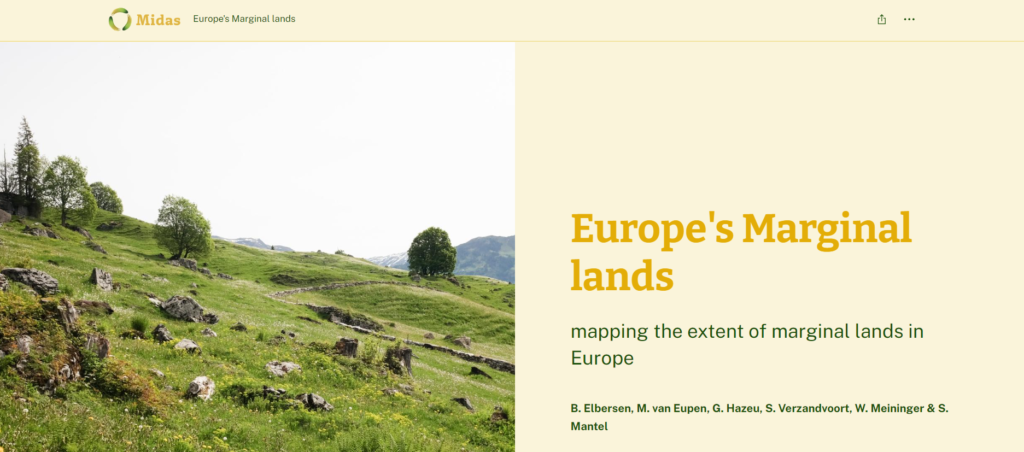This post is an edited version of original content provided by B. Elbersen, M. van Eupen, G. Hazeu, S. Verzandvoort, W. Meininger & S. Mantel.
Across Europe, vast areas of land fall under the classification of marginal agricultural land. This land is characterized by inherent bio-physical limitations that can include factors such as shallow soils, poor drainage, lack of water, low soil organic content, steep slopes and others. Due to these factors, marginal lands are less suitable for conventional agricultural practices, making increased inputs for productivity or benefits barely feasible. These lands offer limited options for diversification without external inputs, and an improper agricultural management poses a significant risk of irreversible degradation and abandonment.
Growing non-edible industrial crops to produce biomass for bio-based materials, energy and fuels, can be an option to utilize marginal land, preserving them from further degradation and reducing the risk of their abandonment, while also minimizing the risk of incurring in indirect land use change (ILUC). This is exactly the aim of MIDAS project: to valorise European marginal land, by growing selected and climate-resilient industrial crops, to eventually build sustainable value chains for a range of innovative bio-based products.
More than one third of agricultural land in Europe shows conditions of marginality
In this context, the MIDAS research team at the University of Wageningen, recently carried out an assessment to improve our understanding of the current and future extension of marginal agricultural land in Europe (plus UK and Serbia), considering the most accurate projections of climate change. This work builds on and adds new knowledge to previous studies conducted by the MAGIC H2020 project. In MAGIC, a detailed mapping of marginal lands found out that about 29% of agricultural land in the EU plus UK can be classified as marginal, due to the single or combined effect of a series of 18 bio-physical factors. In MIDAS the researchers defined and mapped marginal lands for the current (2020) situation and for the future (2050), focusing on those lands that are constrained by biophysical limitations (climate and soil), which make conventional agricultural use challenging, thus having higher chances to become abandoned and/or degraded. This is well explained in this visual storymap prepared by the authors. In the new mapping study, the researchers utilized more detailed data and more accurate methodologies than in the MAGIC study, this led to the conclusion that the actual share of marginal land in the EU plus UK and Serbia can be as high as 32%, or 5.5% more than the previous estimation.

By 2050 we could have less marginal land in the Nordic and Alpine regions but up to 6.6% more in the Mediterranean
The study also estimated the possible extension of marginal land at regional level in 2050, considering the expected effects of climate change on those land. Results show that although the net area of marginal land should not vary significantly in 2050 compared to 2020, relevant variations could take place in different geographic regions of Europe in the next decades. In particular, the Nordic and Alpine regions could see a decrease of marginal land (-12.4% and -10.4% respectively), mainly thanks to the increase of mean temperatures and a reduced soil wetness. This translates into a potential expansion of suitable agricultural lands for food production thanks to an extended crop growing season. On the contrary, the Mediterranean region might see an actual increase of marginal land up to 6.6%, mainly due to adverse climate (high temperatures), combined with a decrease in the stock of soil organic carbon and an increased risk of floodings in certain areas.
Adaptation strategies are needed to preserve soil health
Comparing the maps of marginal lands in 2020 and 2050 reveals an urgent need for Mediterranean farmers to shift towards more drought-tolerant agricultural systems. In the absence of likely changes in the climate trajectories, adaptation strategies will be needed to cope with the effects of climate change on the quality and the fertility of agricultural land. Strategies and practices to manage the risk of floods, as well as to maintain and increase the levels of soil organic carbon in those marginal land, should be extensively demonstrated and deployed in the most sensitive areas. These include practices such as cover cropping, intercropping, agroforestry, using drought-resilient annual and perennial crops, and the use of biochar as a soil amendment.
In line with the EU Green Deal and the EU Soil Strategy, MIDAS is contributing to this objective, by developing climate-resilient crop varieties of a wide array of industrial crops, demonstrating agronomic practices that can mitigate the biophysical factors that contribute to land marginality, and working together with the farmers for the farmers with a bottom-up approach, to develop economically sustainable bio-based value chains for the European Bioeconomy.

